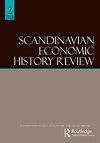瑞典的妇女与财富:以乌普萨拉为例,1850–1910
IF 0.5
Q4 ECONOMICS
引用次数: 0
摘要
摘要在瑞典,人们对女性财富水平和构成的长期变化知之甚少。本文旨在填补这一空白,强调未婚女性财富的主要特征,并评估其在19世纪下半叶是如何演变的。为此,这项研究依赖于1850年至1910年间在乌普萨拉市绘制的约500份遗嘱认证清单的样本。19世纪下半叶是一个转型时期,包括瑞典社会的几个方面。这一变化包括该国的经济和金融结构,以及法律框架和劳动力市场。研究证明,未婚女性的财富在本文分析的时期有所增加,尽管未婚女性和寡妇的财富有所不同。从质量的角度来看,他们的财富也发生了变化,具体资产如房地产和库存中记录的股票的存在越来越多。在可以追溯这一现象起源的几个因素中,更平等的法律框架的发展和住房市场的演变似乎发挥了重要作用。本文章由计算机程序翻译,如有差异,请以英文原文为准。
Women and wealth in Sweden: the case of Uppsala, 1850–1910
ABSTRACT In the Swedish context, fairly little is known about the variation in the level and composition of female wealth over the long term. This paper aims to contribute to filling this gap, emphasising the main features of unmarried women's wealth and assessing how it evolved during the second half of the nineteenth century. To this end, the study relies on a sample of about 500 probate inventories drawn up in the city of Uppsala between 1850 and 1910. The second half of the nineteenth century was a period of transformation encompassing several aspects of Swedish society. The change included the economic and financial structure of the country, as well as the legal framework and the labour market. The research proves that unmarried women's wealth increased in the period here analysed, even though dissimilarly between spinsters and widows. Their wealth changed also from a qualitative point of view, as shown by the increasing presence of specific assets such as real estate and stocks recorded in their inventories. Among the several factors that can be retraced at the origins of this phenomenon, the development of a more equal legal framework and the evolution of the housing market seemed to have played a major role.
求助全文
通过发布文献求助,成功后即可免费获取论文全文。
去求助
来源期刊

SCANDINAVIAN ECONOMIC HISTORY REVIEW
ECONOMICS-
CiteScore
1.60
自引率
16.70%
发文量
20
期刊介绍:
Scandinavian Economic History Review publishes articles and reviews in the broad field of Nordic economic, business and social history. The journal also publishes contributions from closely related fields, such as history of technology, maritime history and history of economic thought. Articles dealing with theoretical and methodological issues are also included. The editors aim to reflect contemporary research, thinking and debate in these fields, both within Scandinavia and more widely. The journal comprises a broad variety of aspects and approaches to economic and social history, ranging from macro economic history to business history, from quantitative to qualitative studies.
 求助内容:
求助内容: 应助结果提醒方式:
应助结果提醒方式:


